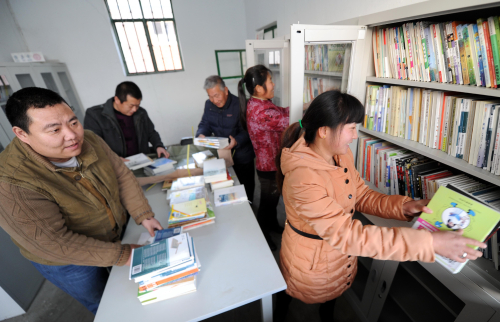|
 |
|
CULTURAL SERVICE: Villagers in Wu Village of Xianghe County in Hebei Province put books on the racks of the village's library. China will strive for equal access to basic cultural services for all, according to an official guideline released on January 14. A "modern public cultural service system" will accentuate basic cultural services and equal access by 2020, according to the guidelines issued by the General Office of the Communist Party of China Central Committee and the State Council General Office (LI XIAOGUO) |
Lottery Sales
China's major lottery, the welfare lottery, saw sales of 205.96 billion yuan ($33.6 billion) in 2014, up 16.67 percent year on year, authorities announced on January 12.
Last year it raised more than 57 billion yuan in public welfare funds, according to the China Welfare Lottery Issuing and Management Center.
Lottery sales are divided up to cover the jackpot as well as lottery management fees and public welfare fund.
The majority of money allocated to the public welfare fund covers social insurance programs, poverty relief, initiatives for the disabled as well as donations to other charity projects.
From 1987 to 2014, sales of the welfare lottery totaled 1,170 billion yuan ($185.8 billion), raising 360 billion yuan ($57.1 billion) in public welfare funds, according to the center.
Open Court Trial
Courts in China continue to move toward public accessibility.
China will work to make court trials more open, Liu Xuewen, a senior official with the Supreme People's Court, said on January 14.
He went on to say that courts at all levels should keep working on the litigation system, which is decisive for confirming evidence, establishing facts and reaching fair judgments.
Residential Rental Market
China will establish a diversified and standardized residential rental market within three years, according to the Ministry of Housing and Urban-Rural Development.
With home prices increasing, more people, especially transmigrants, are choosing to rent accommodation and the market needs proper regulation, the ministry said on January 14.
The ministry said it would build a government-led service portal for rental information, and encourage estate agents to either lease or purchase social housing apartments to rent to the public.
Meanwhile, the ministry will support developers who wish to rent property to the public and pilot specific funds to bring social capital into the market.
The ministry asked local authorities to step up policy support of the scheme.
Urbanization in Tibet
Southwest China's Tibet Autonomous Region plans to push its urbanization rate over 30 percent by 2020.
The region decided to increase the permanent urban population by nearly 280,000 by the year 2020, with three cities or towns with a population of up to 500,000, and two cities or towns with a population of up to 100,000, according to a conference on urbanization on January 14.
The number of towns and cities in the region has increased from 31 in 1990 to 140 in 2013. The region's urban population has hit 740,000 in 2013 against 287,000 in 1980. In the process, transportation, energy supplies and communications have also improved. The largest city and regional capital Lhasa currently has a population of less than 300,000.
Last March, China unveiled a national urbanization plan (2014-20) designed to steer urbanization onto a more human-centered, environmentally friendly path. | 